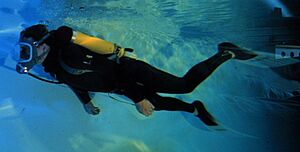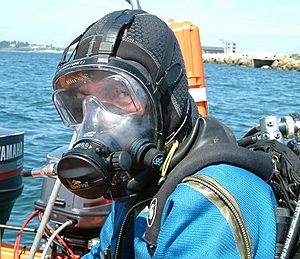Full-face diving mask facts for kids

The AGA Divator full face mask is used by military and civilian divers
|
|
| Other names | Band-mask |
|---|---|
| Uses | Provision of breathing gas, underwater vision, and sometimes communications for underwater divers |
| Inventor | Yves le Prieur |
| Related items | Diving helmet, Diving regulator, Diver communications, Diving mask |
A full-face diving mask is a type of diving mask that seals the whole of the diver's face from the water. It has several functions:
- It lets the diver see clearly underwater.
- It protects the diver's face from cold or polluted water and from stings from jellyfish or coral.
- It is more secure than a mouthpiece alone. It will allow a diver to breathe even if they become unconscious or suffers an oxygen toxicity convulsion, making them unable to grip a mouthpiece.
Full-face diving masks are often used in professional diving. They are not often used in recreational diving.
Safety
Some full-face masks have a valve that lets the diver switch between breathing from the set and breathing from the atmosphere. It is called a "dive/surface valve" or "snorkel valve." The diver can easily use it even if they are wearing thick diving gloves. However, it cannot be easily knocked against things in low visibility water or in hand-to-hand combat underwater.
A full-face mask provides better security of breathing gas supply than a half-mask if there is a risk of the diver losing consciousness underwater.
The mask faceplate is made of a strong polymer that is securely attached to the skirt or frame. Many masks include a mouthpiece in case of accidental flooding.
Because face shapes and sizes differ, not all divers will get a perfect seal from the skirt of all full-face masks. Most divers will be able to find a mask that works for them. Divers can "purge" (push water out of) the mask while they are underwater.
History
A full-face diving mask was invented by Yves le Prieur in 1933.
The free-flow type of full-face mask is sometimes referred to as a Jack Browne rig, named for a DESCO engineer who designed an early version of a full-face mask with a free-flow air supply from the surface.
Interesting facts about full-face diving masks
- Many full-face dive masks come with curved safety lenses. This helps divers see more than they can with a flat lens.
- Using a standard scuba diving mask for a long time often results in jaw pain, but with a full-face mask, divers do not have to bite down on a mouthpiece.
- Divers can communicate well with other divers because they are not biting down on a mouthpiece.
- A full-face diving mask fogs less on the inside than a regular diving mask.
- In cold water, a full-face diving mask keeps a diver's face warmer than a regular scuba diving mask.
- Full-face diving masks do not have a snorkel attached.
- For divers who have problems wearing standard masks due to their mustaches and beards, the full-face mask is a better choice because it completely covers the face.
- It takes longer to clear a full-face scuba diving mask than a regular scuba diving mask.
- Divers wearing full-face masks may tire more quickly than those wearing a standard mask because the full-face mask makes a diver's head more buoyant, and they have to work harder to keep their body in the correct swimming form.
- Full-face masks are more expensive than regular scuba masks.
See also
- Self-contained breathing apparatus, many of them have full-face masks.
- Gas mask, most gas masks are full-face masks.
- Diving helmet
- Diving mask




